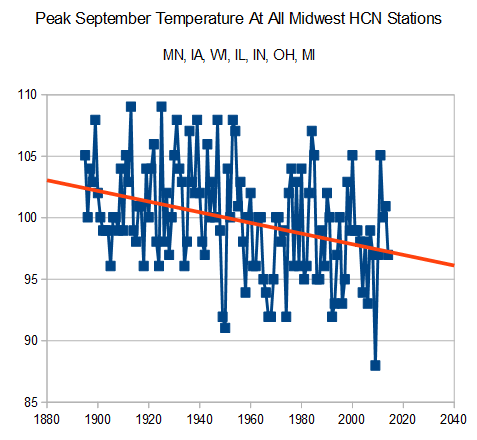Prior to 1950, 100 degree temperatures in the midwest were very common. They almost never happen any more.
Disrupting the Borg is expensive and time consuming!
Google Search
-
Recent Posts
- Fact Checking NASA
- Fact Checking Grok
- Fact Checking The New York Times
- New Visitech Features
- Ice-Free Arctic By 2014
- Debt-Free US Treasury Forecast
- Analyzing Big City Crime (Part 2)
- Analyzing Big City Crime
- UK Migration Caused By Global Warming
- Climate Attribution In Greece
- “Brown: ’50 days to save world'”
- The Catastrophic Influence of Bovine Methane Emissions on Extraterrestrial Climate Patterns
- Posting On X
- Seventeen Years Of Fun
- The Importance Of Good Tools
- Temperature Shifts At Blue Hill, MA
- CO2²
- Time Of Observation Bias
- Climate Scamming For Profit
- Climate Scamming For Profit
- Back To The Future
- “records going back to 1961”
- Analyzing Rainfall At Asheville
- Historical Weather Analysis With Visitech
- “American Summers Are Starting to Feel Like Winter”
Recent Comments
- Bob G on Fact Checking NASA
- Bob G on Fact Checking NASA
- Jack the Insider on Fact Checking NASA
- arn on Fact Checking NASA
- Bob G on Fact Checking NASA
- arn on Fact Checking NASA
- Bob G on Fact Checking NASA
- conrad ziefle on Fact Checking NASA
- conrad ziefle on Fact Checking NASA
- Bob G on Fact Checking NASA



my understanding of long ago was that Greenhouse Gas theory was
More GHG = more cloud
More cloud = cooler days and warmer nights, effect most felt in winter (what’s not to like)
Your charts of declining maximums might be showing the effects of GHG – so long as it doesn’t drag us into an ice age, it is all good, better weather, longer growing seasons and increased C02 good for all that is growing.
There is no evidence to support that idea
1950 ~100°F
2010 ~ 97-98°F
60 year period gives around a 2°F-3°F fall.
The decline runs at about -1°F to 1.5°F per 30 years or so. That is still quite rapid, just not fast enough for most humans to ‘feel’.
~3.5°F fall over a lifespan will not be noticed.